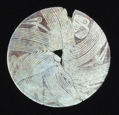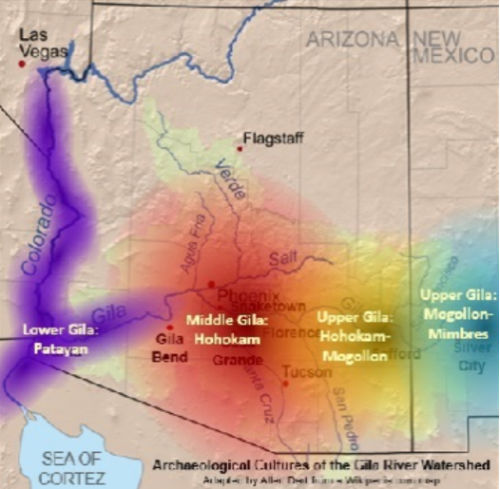
Mr. Allen Dart, a Registered Professional Archaeologist, is the executive director of Tucson’s nonprofit Old Pueblo Archaeology Center, which provides educational and scientific programs in archaeology, history, and cultures. Al has worked and volunteered as a professional archaeologist
in New Mexico and Arizona since 1975 for state and federal governments, private companies, and nonprofit organizations. He served as President of the Arizona Archaeological and Historical Society (AAHS) in 1991- 1993 and founded Old Pueblo Archaeology Center in 1993 to provide educational and scientific programs in archaeology, history, and cultures. A member of several archaeology advocacy organizations, he has received the Arizona Governor’s Archaeology Advisory Commission Award in Public Archaeology (1997), the Arizona Archaeological Society’s Professional Archaeologist of the Year Award (2012), the AAHS Victor R. Stoner Award (2016), and other honors from AAHS, the Arizona State Historic Preservation Office, the Arizona Archaeological Council, the U.S. National Park Service, the U.S. Natural Resources Conservation Service, and other organizations for his research and his efforts to bring archaeology and history to the public.
Since 1997 Mr. Dart has been a member of the Arizona Humanities (AH) Roads Scholar and AZ Speaks panels, giving presentations about archaeology and cultures to nonprofit organizations throughout Arizona. He offers “The Antiquity of Irrigation” and “Old Time Religion” talks described below through AH but can give those and all of the others described below through Old Pueblo to organizations that do not qualify for or need AH program support.
Presentations Listed Alphabetically

Ancient Native American Pottery of Southern Arizona: Mr. Dart shows digital images of Native American ceramic styles that characterized specific eras in Arizona prehistory and history, and discusses how archaeologists use pottery for dating archaeological sites and in- terpreting ancient lifeways. He discusses the importance of context in archaeology, how things people make change in style over time, and how different styles are useful for iden- tifying different cultures and for dating pottery. He also shows illustrations of the pottery styles that were made in southern Arizona by the ancient Early Ceramic and Hohokam cul- tures, and historically by Piman (Tohono O’odham and Akimel O’odham), Yuman (including Mohave and Maricopa), and Apachean peoples from as early as 800 BCE into the early twentieth century.

Ancient Southwestern Native American Pottery: In this presentation Mr. Dart shows and discusses Native American ceramic styles that characterized specific eras in the U.S. South- west prior to about 1450, and talks about how archaeologists use pottery for dating archae- ological sites and interpreting ancient lifeways. He discusses the importance of context in archaeology, how the things people make change in style over time, and how different styles are useful for identifying different cultures and for dating archaeological sites. His many illustrations include examples of ancient pottery types made throughout the American Southwest from about 2000 to 500 years ago.

The Antiquity of Irrigation in the Southwest: Before 1500 CE, Native American cultures took advantage of southern Arizona’s long growing season and tackled its challenge of limi- ted precipitation by developing the earliest and most extensive irrigation works in all of North America. Agriculture was introduced to Arizona more than 4,000 years before present, and irrigation systems were developed in our state at least 3,500 years ago – several hundred years before irrigation was established in ancient Mexico. This presentation by archaeologist Allen Dart provides an overview of ancient irrigation systems in the southern Southwest and discusses irrigation’s implications for understanding social complexity.

Archaeological Investigations in Marana’s Crossroads at Silverbell District Park: In this presentation Mr. Dart illustrates artifacts, architecture, and other material culture of southern Arizona’s ancient Hohokam culture, and discusses the archaeological excavations that Old Pueblo Archaeology Center and Desert Archaeology, Inc., conducted at the prehistoric Yuma Wash Hohokam village archaeological site and the historic Bojórquez-Aguirre Ranch site, which are in the Town of Marana’s Crossroads at Silverbell District Park near the Wheeler Taft Abbett Sr. Library.
Archaeology and Cultures of Arizona: Many different peoples have contributed to making Arizona such a unique and fascinating cultural place. In this program Mr . Dart summarizes and interprets the archaeology of Arizona, from the earliest Paleoindians through Archaic period hunters and foragers, the transition to true village life, and the later prehistoric archaeological cultures (Puebloan, Mogollon, Sinagua, Hohokam, Salado, and Patayan). He also discusses connections between archaeology and history, and provides an overview of the Native American, European, Mexican, African, and Asian peoples who have contributed to the Southwest’s recent history. “Archaeology and Cultures of Arizona” is a 2-hour presentation.

Archaeology and You: Preserving the Past for the Future: Tombs in an ancient Maya city are sacked by looters seeking artifacts to sell. Relic collectors lease an archaeological site and dig it up to collect artifacts, leaving craters littered with human bones and broken grave objects. A petroglyph is chiseled out of a rock face. These actions destroy part of the archaeological record of humankind. In this presentation Mr. Dart notes that artifacts and cultural features ranging from small pieces of pottery and arrowheads to petroglyphs, glass bottles, coins, and other historical objects often are the only sources of information that archaeologists have to answer questions about an ancient people’s way of life, which makes it important for these items to be left undisturbed in their original context.

Archaeology’s Deep Time Perspective on Environment and Social Sustainability: The deep time perspective that archaeology provides on natural hazards, environmental change, and human adaptation not only is a valuable supplement to historical records, it sometimes contradicts historical data that modern societies use to make decisions affecting social sustainability and human safety. What can be learned from archaeological evidence that virtually all prehistoric farming cultures in the Southwest eventually reached a threshold of unsustainability, which probably was a
factor in the ultimate collapse or reorganization of their societies? Could the 2011 Japanese tsunami’s disastrous effects on nuclear power plants have been avoided if the engineers who decided where to build those plants had not ignored prehistoric archaeological evidence of tsunamis? This presentation looks at archaeological evidence for how human cultures adapt to environmental change.

Arts and Culture of Ancient Southern Arizona Hohokam Indians: The Hohokam Native American culture flourished in southern Arizona from the sixth through fifteenth centuries. Hohokam artifacts, architecture, and other material culture provide archaeologists with clues for identifying where the Hohokam lived, for interpreting how they adapted to the Sonoran Desert for centuries, and explaining why the Hohokam culture mysteriously disappeared. In this presentation Mr. Dart illustrates artifacts, rock art, and other cultural features of the Hohokam and presents possible interpretations about this culture’s relationships to the natural world, their time reckoning, religious practices, beliefs, and deities, and possible reasons for the eventual demise of their way of life. The program features illustrations of archaeological artifacts and features that archaeologists use to define the Hohokam culture.

Hohokam and Mimbres Art and Ideology: Comparison of New Mexico’s Classic Mimbres (AD 1000-1130) rock art and that of the contemporaneous Hohokam culture of southern Arizona helps define the spheres of those cultures’ art and ideology. Certain icons are common to both Hohokam and Mimbres rock art, whereas each culture also exhibits repeated motifs that apparently were not produced by the other. Comparison and contrast of the shared and unshared rock art images, and of other aspects of Hohokam and Mimbres cultures, suggest similarities as well as differences in their respective religious beliefs and practices.

The Hohokam Southern Frontier Revisited: Excavations at the Continental Site in Green Valley: Between 650 and 1450 CE a prehistoric agricultural people who archaeologists call the Hohokam were living in southern Arizona, constructing earth-covered wood-and-brush houses built in shallow pits, and producing distinctive pottery and other crafts from stone, bone, and seashells. It has been suggested the Hohokam culture extended southward up the Santa Cruz River valley well beyond Green Valley, Arizona. Recent research at the Continental archaeological site and other places in the Santa Cruz Valley suggests, however, that after 950 CE the Green Valley-southward area was the territory of another ancient culture contemporary with, but different from the Hohokam.

Modern and Historical O’odham Culture: The “Four Southern Tribes” of Arizona share a close relationship with one another and can trace their ancestry to people who inhabited south-central Arizona and part of northern Mexico through geographical, archaeological, linguistic, oral tradition, and historical evidence. These modern tribes refer to themselves as “O’odham” (‘people’) in their native language and historically have been called the Papago and Pima Indians. They occupy several southern Arizona Indian reservations but many of their members live and work in communities beyond the reservation boundaries, in Arizona and elsewhere. This presentation provides a brief introduction to the historical and modern O’odham cultures, their roots in the ancient Paleoindian, Archaic, and Hohokam cultures identified by archaeologists, and their prominent place in the modern world.

Old-Time Religion? The Salado Phenomenon in the U.S. Southwest: In the early 20th century, archaeologists in the southwestern U.S. viewed a constellation of distinctive cultural traits – multicolored pottery, houses arranged in walled compounds, and monumental architecture – as evidence of a cultural group they termed “Salado.” Subsequent discoveries cause us to question what the Salado traits really represent. In this presentation archaeologist Allen Dart illustrates some of the so-called Salado culture attributes, reviews theories about Salado origins, and discusses how Salado relates to the Ancestral Pueblo, Mogollon, Hohokam, and Casa Grandes cultures of the U.S. Southwest and Mexico’s Northwest.

Set in Stone but Not in Meaning: Southwestern Indian Rock Art: Ancient Indian pictographs (rock paintings) and petroglyphs (symbols carved or pecked on rocks) are claimed by some to be forms of writing for which meanings are known. But are such claims supported by archaeology or by Native Americans themselves? Mr. Dart illustrates southwestern petroglyphs and pictographs, and discusses how even the same rock art symbol may be interpreted differently from popular, scientific, and modern Native American perspectives.

Southwestern Rock Calendars and Ancient Time Pieces: Southwestern Native Ameri- cans developed sophisticated skills in astronomy and predicting the seasons, centuries before Old World peoples first entered the region. In this presentation Mr. Dart discusses historically known sky-watching practices of various southwestern peoples and how their ancestors’ observations of the heavens may have been commemorated in ancient architecture and rock symbols. The program illustrates astronomical align- ments and possible calendrical reckoning features at such places as the Hovenweep area of Utah, the Mesa Verde and Chimney Rock regions of Colorado, New Mexico’s Chaco Canyon archaeological district, and sites in Arizona including Ancestral Pueblo ruins in northeastern Arizona and the Casa Grande Ruins and Picture Rocks Hohokam sites farther south.
Mr. Dart accepts suggestions for speaking about other archaeology-related topics. For more information or to schedule a presentation contact him at
Old Pueblo Archaeology Center
PO Box 40577
Tucson AZ 85717-0577 USA 520-798-1201 or adart@oldpueblo.org
